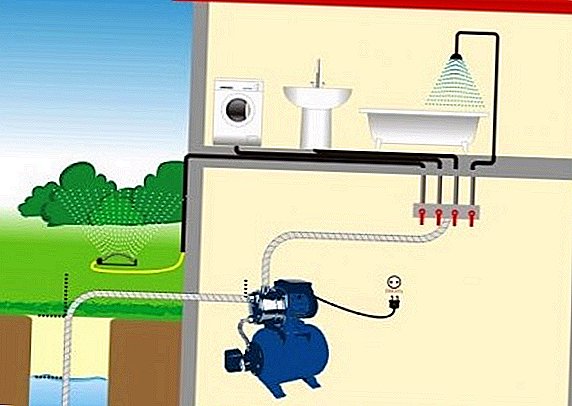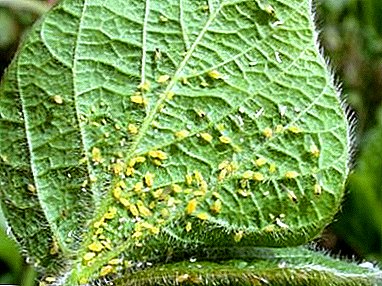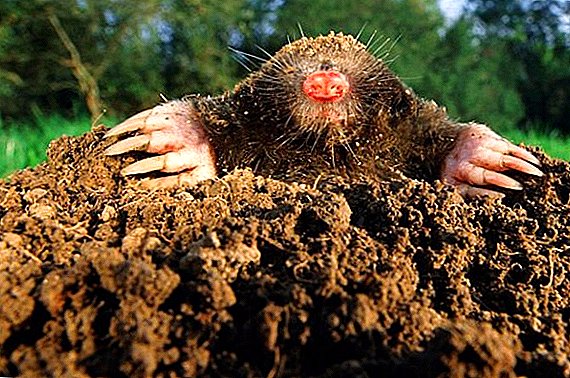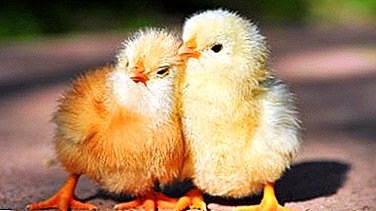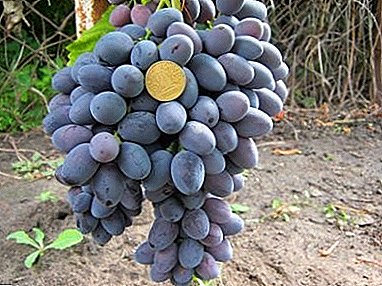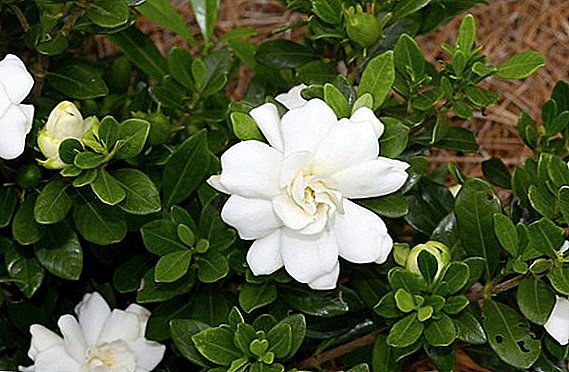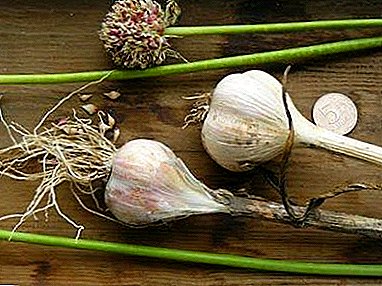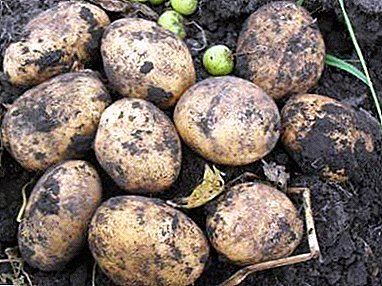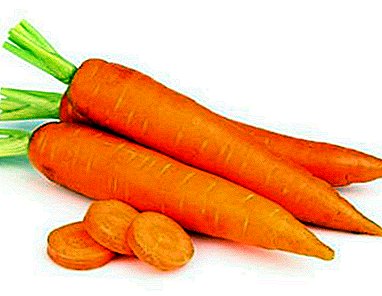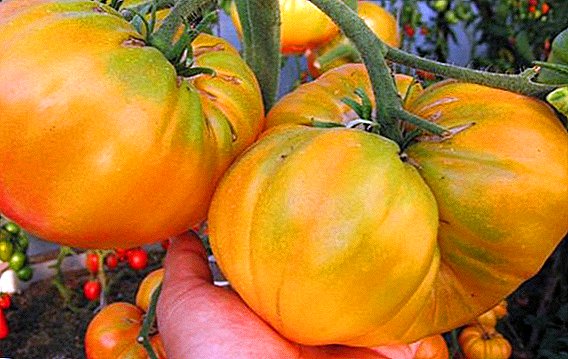 On the shelves in stores you can often find yellow tomatoes.
On the shelves in stores you can often find yellow tomatoes.
Despite their unusual appearance, they are not inferior in utility to the usual varieties of tomatoes, and the lack of red pigment makes them hypoallergenic.
Learn more about the popular "Yellow Giant" variety, which is ideal for preparing fragrant summer salads.
Variety description
"Yellow Giant" refers to the indeterminate varieties of tomatoes, which means that its growth practically does not stop. On average, the bush grows to 1.2-1.7 meters, often up to 1.8 meters. The green mass of the plant does not stop growing until frost.  This variety has such advantages:
This variety has such advantages:
- large fruits;
- sweet taste;
- prolonged fruiting;
- grown in open ground and in greenhouses.
Minuses:
- the fruit is too large, so the whole does not fit in the jar;
- not stored for a long time.
The indeterminate tomato varieties also include such as "Honey", "Cherokee", "Pepper-like giant", "Ladies' man", "Cosmonaut Volkov", "President", "Cornabel F1".
Also, the "Yellow Giant" has a number of drawbacks that are characteristic of other yellow tomato varieties:
- long development of the vegetative part;
- later fruit ripening;
- can not be grown in open ground in regions with a short summer.
Among the distinguishing features of the "Yellow Giant" are:
- prolonged fruiting;
- sweet taste;
- pleasant aroma;
- no cracking fruit.

Fruit characteristics and yield
Variety refers to mid-ripening - the duration of ripening is 110-122 days from the moment of planting. Harvested repeatedly, until frost.
Up to 5.5 kg of fruits with a weight of 200-300 g can be removed from one bush; some may weigh about 400 g. The fruit is flat or round. It has an increased sugar and beta-carotene content, which makes its flesh sweet.
Selection of seedlings
Rules for choosing seedlings "Yellow giant" are the same as for other varieties of tomatoes:
- Find out the age of seedlings. Ideal for planting suitable 45-60 day seedlings, not older.
- Permissible stem height up to 30 cm; it should be 11-12 leaves.
- The stalk should be as thick as a pencil and have a rich green foliage color.
- The root system must be well formed, without damage.
- Each shrub seedlings need to be examined for the presence of pests (their eggs are usually under foliage). Also, there should be no stains on the stem, and the leaves should not look wrinkled.
- It is necessary to look that the seedlings were in boxes with the earth and not sluggish.
Important! Having noticed at least one flaw on the bushes, it is better to choose seedlings from another seller.
Growing conditions
The bed for planting tomatoes must be prepared in autumn. It is plowed and fertilized (30-40 g of superphosphates and 25-30 g of potash fertilizer per 1 square meter). The acidity of the soil should be 6.5 pH. If it is increased, then add 0.5-0.9 kg of lime, 5-7 kg of organic matter and 40-60 g of superphosphates.  The bed should be located in the southern, southwestern or southeastern part of the plot. It can be planted seedlings when the earth warms to 15 ° C.
The bed should be located in the southern, southwestern or southeastern part of the plot. It can be planted seedlings when the earth warms to 15 ° C.
When growing tomatoes in a greenhouse, the air humidity should be 60-70%, and the temperature should be up to 23 ° С, until shoots appear; then it should be lowered to 10-15 ° С during the daytime and 8-10 ° С at night.
The best predecessors of tomatoes:
- cucumbers;
- cabbage;
- zucchini;
- bow.
In the area where they grew peppers, potatoes or eggplants, tomatoes can be planted only a few years later.
Seed preparation and planting
Seeds can be harvested independently or purchased in stores. When purchasing seed, it is important to make sure that it has been treated for diseases and pests.
When self-harvesting seeds, they must be disinfected - for this, the dry seed must be heated 48 hours at 30 ° C and 72 hours at 50 ° C. Before sowing, seeds should be soaked in a 1% solution of potassium permanganate for half an hour, and then washed under running water for 10 minutes.  Sow the seed for seedling for 60-65 days before the planned time of planting young bushes in open ground. In the soil, grooves are made with a depth of 1 cm with a distance of 5-6 cm between them. Seeds are placed there with an interval of 2 cm and sprinkled with earth. Then a bed or a box with future seedlings is covered with a film until the first shoots.
Sow the seed for seedling for 60-65 days before the planned time of planting young bushes in open ground. In the soil, grooves are made with a depth of 1 cm with a distance of 5-6 cm between them. Seeds are placed there with an interval of 2 cm and sprinkled with earth. Then a bed or a box with future seedlings is covered with a film until the first shoots.
Maintenance and care
The scheme of planting in open ground - tape or chess, with a distance of at least 60 cm between seedlings and between rows.
After removing the film from the garden, seedlings are sprayed with a spray of water. When the bushes are seated on permanent seats, watering is needed more abundant - 0.7-0.9 liters should go to one seedling.
Irrigation of seedlings is desirable in the afternoon or in cloudy weather, and before loosening the soil. Loosening is done between the rows and in the rows themselves 1 time for 10-12 days. Together with loosening and weed control is carried out.
Important! If tomatoes grow in heavy ground, it is necessary to deeply loosen the soil for 10-15 days after planting.
The first hilling of a tomato bush is made in 9-11 days from the date of transplanting. Before the procedure you need to water the plants. Next time you need to spud in 16-20 days.  Over the summer, the bushes of the "Yellow Giant" should be fed three times:
Over the summer, the bushes of the "Yellow Giant" should be fed three times:
- The first time fertilizers are applied to the soil 10 days after transplanting. Fertilized with bird droppings or cow dung diluted in water (1 kg per 10 liters). After making the feeding is necessary to carry out mulching.
- When the ovary appears on the bush on the second hand, after a week you can fertilize the plant again. A solution of the fertilizer "Mortar", copper sulfate and potassium permanganate (3 g per 1 bucket of water) is used. Under each bush pours 2 liters.
- The last time fertilizing is done when the first fruits begin to ripen. The solution is the same, but 2.5 liters per bush.
“Yellow giant” is a tall variety with abundant fruiting, therefore, in order for the bush to bear the weight of the fruit, it must be tied up. As a support, you can use the trellis or just stakes.
When using a trellis, stakes are driven in with a gap of four meters and a thread is pulled between them - a bush is tied to it. Stakes are located on the north side of the plant at a distance of 9-11 cm from the stem. The first time the bush is tied up immediately after the transplanting; then, as you grow, at the level of the second and third brushes.
To obtain high yields, the Yellow Giant Tomato should be stepson, leaving two stalks. If you need fruits of especially large size, then one stalk is left.  Also, to adjust the growth of the bush, you need to pinch its top, so that during flowering and fruiting, all the forces go to the formation of the ovary.
Also, to adjust the growth of the bush, you need to pinch its top, so that during flowering and fruiting, all the forces go to the formation of the ovary.
Did you know? In 1544, the Italian botanist Pietro Mattioli first described the tomato, calling it "Pomi d'oro" (golden apple). Hence the word "tomato", and the word "tomato" has French roots and comes from "tomate".
Disease and pest prevention
The variety is highly resistant to most pests and diseases. It affects only phytophthora, tobacco mosaic and Colorado potato beetle.
To combat late blight use drugs "Ordan", "Barrier", "Barrier". They are processed before the beginning of the flowering period. When the first ovary appears, use 1% solution of potassium permanganate mixed with a glass of ground garlic (0.5 l per 1 sq. Meter).
If the plant is completely struck by the disease, then it is easier to pry and burn.
To reduce the likelihood of plant contamination with tobacco mosaic, seeds should be treated with a 1% solution of potassium permanganate before planting. In case the disease has just begun to manifest itself, the affected leaves break down and are burned. With a strong defeat the bush is pulled out and burned outside the site.
Colorado potato beetle attacks only young seedlings. The fight with him begins when the first beetles appear in the garden; It uses the same tools as for potatoes. It is best to spray biopreparations "Bitoksibaktsillin", "Colorado", "Fitoverm", "Bicol." 
Harvesting and storage
Harvest "Yellow Giant" several times during the season. The first harvesting can be carried out 120 days after sowing the seeds - by this time the fruit should have acquired a rich yellow color. The last cleaning must be done before the temperature drops below 8 ° C.
The fruits of this variety are not stored for a long time, but a little improvement in the index of quality is possible, if you collect tomatoes without defects, dense and medium maturity.
Tomatoes are stored in boxes, in one row, peppered with shavings of deciduous trees. If there is no shavings, you can use paper - they line the box and cover each fruit. In the room where tomatoes are stored, there should be a humidity of 85-90% and good ventilation.
Did you know? The first recipes using tomatoes were found in a cookbook dated 1692 and published in Italy. But they assume that they came from Spanish sources.
"Yellow giant" - ideal for those who love tomatoes, but can not eat them because of allergies. The variety is quite unpretentious; It can be grown both in greenhouses and in the open field. With proper care, you will enjoy the sweet taste of these fruits until frost.


